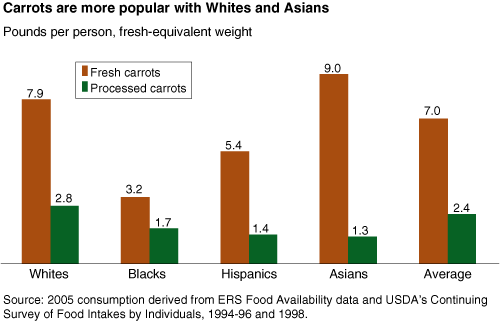Carrot Consumption Varies With Age, Income, and Race
- by Biing-Hwan Lin and Gary Lucier
- 4/1/2008
People choose which vegetables to eat based on vegetable prices and individual incomes and preferences, which reflect certain demographic characteristics, such as people’s age, education, race/ethnicity, and where they live. These demographically shaped preferences are noticeable in the consumption patterns for one long-time American favorite—the carrot.
Carrots are a favorite American vegetable because of their versatile culinary uses and rich nutritional content. They are a common ingredient in stews, soups, stir-fry dishes, and salads. The development of convenient, fresh-cut carrot products, such as baby carrots, has helped secure the carrot’s place as a healthy snack option and lunchbox mainstay. A recent ERS study examines where and how many fresh and processed carrots are eaten and links this consumption to various economic, social, and demographic characteristics of consumers.
In 2006, the amount of carrots available for U.S. consumption stood at 12.0 pounds per person—8.7 pounds of fresh carrots and 3.3 pounds in canned, frozen, or other processed uses. For both fresh and processed carrots, retail sales for at-home consumption dominated. The away-from-home market accounted for 2.2 pounds per person, with more than half of that consumed at sit-down restaurants.
Using data from nationally representative surveys, ERS researchers found that preferences for carrots vary by race and ethnicity, age, and income. Non-Hispanic Whites ate 10.7 pounds of carrots per person at home in 2005, and Asian Americans ate 10.3 pounds per person. Asian Americans ate the most fresh carrots among the racial/ethnic groups (9.0 pounds per person). Non-Hispanic Blacks consumed 3.2 pounds per person of fresh carrots but were the second largest consumers of processed carrots at 1.7 pounds per person.
At-home carrot consumption rises with age and income. For example, those 65 and older ate 13.3 pounds of carrots per person in 2005, compared with 6.8 pounds per person for those younger than 40. Households with incomes over 350 percent of the Federal poverty level consumed 11.1 pounds of carrots per person, compared with 7.8 pounds per person in households with incomes below 185 percent of the poverty level.
America’s appetite, like its population, is always changing. The country is becoming more ethnically diverse, with an influx of Hispanic Americans who tend to eat fewer carrots than the national average. At the same time, the U.S. population is growing wealthier, older, and more educated, factors which bode well for greater carrot consumption.
This article is drawn from:
- Factors Affecting Carrot Consumption in the United States. (2007). USDA, Economic Research Service.



